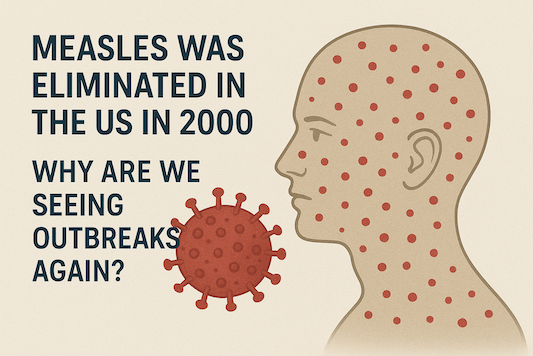Stay updated on what is trending in health. Discover tips and resources for a healthier, balanced life.
Measles Was Eliminated in the US in 2000. Why Are We Seeing Outbreaks Again?
Learn why measles outbreaks are rising, how it spreads so fast, who’s at risk, and how vaccines protect you and your community. Stay informed — stay protected.
DISEASES AND CONDITIONS
Dr. S. Ali
12/15/20257 min read


Top Questions Answered
A disease declared eliminated from the U.S. over two decades ago is now surging back. Recent measles outbreaks have led to school closures, overwhelmed emergency rooms, and placed unvaccinated children at serious risk — all from a virus we’ve been able to prevent since 1963.
You might think of measles as a simple rash, but this highly contagious virus can cause serious complications — even death — especially in young children and vulnerable adults. In this clear, easy-to-follow Q&A, we’ll break down why measles is spreading again, how it moves so quickly from state to state, what symptoms to watch for, and why staying up to date on vaccination is still the best way to protect yourself, your family, and your community.
1. Why are measles cases rising in the U.S.?
Declining vaccination rates, increased global travel, and growing pockets of unvaccinated communities have allowed measles — which was declared eliminated in the U.S. in 2000 — to make a dangerous comeback. Outbreaks often begin when unvaccinated travelers bring the virus home from countries where measles is still circulating. Once intorduced, the highly contagious virus spreads quickly through communities with low vaccination coverage. Misinformation about vaccine safety, vaccine hesitancy, and disruptions to routine childhood vaccinations (especially during the COVID-19 pandemic) have further reduced immunity in some areas, making it easier for outbreaks to occur.
2. How does measles spread from state to state?
Measles doesn’t respect borders — it spreads fast, and in several ways:
Travel-related spread: When unvaccinated travelers catch measles abroad, they can unknowingly bring it back home. Since the virus can linger in airplane cabin air, other passengers may be exposed mid-flight. One well-known example: the 2019 New York outbreak started with travelers returning from Israel.
Large events: Big gatherings like sports events, concerts, or conferences can bring together people from many states — making it easy for measles to hitch a ride home with them. In fact, measles exposures linked to the 2024 Super Bowl affected people in three states!
Mobile populations: College students heading home for break, migrant workers moving between job sites, or military families relocating between bases — all can help the virus move from one community to another.
Delayed detection: In the early stages, measles looks like a regular cold — runny nose, cough, fever — so people often travel or go about their daily routines while contagious, before they even realize what they have. That’s part of why measles spreads from tsate to state so quickly.
3. Why does measles spread so fast?
It’s one of the most contagious diseases out there — here’s why:
It spreads like wildfire: About 90% of unvaccinated people who are exposed will catch it. That’s nearly everyone!
You’re contagious for days — even before you know you’re sick: People with measles can spread the virus for about 8 days total — starting 4 days before the rash shows up, and continuing 4 days after. So, they may unknowingly infect others before realizing they have measles.
Too many gaps in protection: In some communities, MMR vaccination rates have dropped below the 95% needed to keep outbreaks at bay. That leaves the door wide open for the virus to spread.
4. How do you catch measles?
It’s easier than you might think. You can catch measles just by breathing the same air as someone who’s infected. When they cough or sneeze, tiny droplets carrying the virus hang around in the air — and can even settle on surfaces. The virus can stick around for up to 2 hours after the person leaves. You don’t have to touch them or even be in the room at the same time!
5. How contagious is measles?
Incredibly contagious. If one person with measles is in a room full of unvaccinated people, about 9 out of 10 will catch it. Even after that person is gone, the virus can linger in the air for up to 2 hours — so others walking in later are still at risk.
6. What’s the incubation period?
After you’ve been exposed, it usually takes about 10 to 14 days before you start showing symptoms. But here’s the tricky part — you can spread measles to others before you even realize you’re sick. People are contagious about 4 days before the rash appears, which makes early spread hard to catch.
7. What are the symptoms?
At first, measles can feel a lot like a bad cold. You might notice:
A high fever (can spike up to 104°F)
Cough, runny nose, and red, watery eyes
A rash that starts on the face and spreads downward
Tiny white spots inside the mouth (called Koplik spots — a telltale sign)
In more severe cases, measles can lead to dangerous complications like pneumonia, brain swelling (encephalitis), or even death.
8. What complications can measles cause?
Measles isn’t just a rash — it can cause serious, long-term health problems, especially in young children and vulnerable groups.
Common issues include:
Severe diarrhea, which can cause dangerous dehydration
Ear infections, sometimes leading to permanent hearing loss
Pneumonia — the leading cause of measles-related deaths
More severe complications:
Brain swelling (encephalitis) — happens in about 1 in every 1,000 cases
Death — 1 to 3 in every 1,000 cases
“Immune amnesia” — the virus can wipe out your immune memory, making you more vulnerable to other illnesses for years after recovery
Pregnant women face higher risks, too — measles during pregnancy can lead to early birth, low birth weight, or even pregnancy loss.
9. If I’m vaccinated, am I still at risk?
If you’ve had two doses of the MMR vaccine, you’re about 97% protected — that’s very good! While it’s possible (but rare) to get measles even when vaccinated, those “breakthrough” cases are usually much milder.
10. Who’s most at risk from measles?
The people who face the biggest risks are:
Unvaccinated children, especially those under 5
Pregnant women
People with weakened immune systems (such as those with cancer or on immune-suppressing medications)
11. How effective is the MMR vaccine?
Two doses of the MMR vaccine give most people lifelong protection. Since the vaccine was introduced in 1963, measles cases in the U.S. have dropped by an incredible 99%. It remains one of the best tools to prevent outbreaks.
12. Why do some parents skip the vaccine?
Unfortunately, a mix of reasons keeps vaccination rates lower than they should be:
Misinformation — especially long-debunked myths linking vaccines to autism
Religious objections
A sense of complacency — because measles had been rare for many years, some people underestimate the danger
13. What should I do if I think someone in my family might have measles?
First — don’t rush straight to a doctor’s office!
Measles is extremely contagious, and you could unknowingly expose others.
Here’s what to do instead:
Call your doctor first — they can advise you on next steps
Isolate immediately — remember, people are contagious 4 days before and after the rash appears
Keep an eye out for serious warning signs, like trouble breathing or confusion, and seek emergency care if these occur.
14. Can you catch measles from surfaces?
Yes — though breathing in airborne droplets is the main way it spreads, measles virus can live on surfaces (like doorknobs or tables) for up to 2 hours. It’s another reason good hygiene and vaccination are key!
15. Is it safe for adults to get vaccinated against measles?
Absolutely. If you never got vaccinated or aren’t sure about your status, it’s very safe — and highly recommended — to get the MMR vaccine as an adult. The exceptions: pregnant women and people with certain severe allergies should wait and talk to their doctor.
16. What if I don’t know if I’ve been vaccinated?
Here’s what you can do:
1️ Check with parents, old school records, or past doctors
2️ Ask your doctor about a simple blood test to check immunity
3️ If in doubt, it’s safe to just get vaccinated again — extra doses won’t harm you
17. Why is measles especially dangerous for kids?
Young children (especially under 5) face the highest risks because their immune systems aren’t as strong. Complications can include:
Severe diarrhea → dehydration
Ear infections → possible permanent hearing loss
Pneumonia — the top cause of measles deaths
Brain swelling (encephalitis), which can be life-threatening
18. Can measles affect pregnancy?
Yes. If a pregnant woman catches measles, it can lead to:
Early (premature) birth
Low birth weight
Pregnancy loss (miscarriage)
More severe measles symptoms for the mother
That’s why it’s so important for women of childbearing age to check their vaccination status — before pregnancy.
19. How common was measles in US before vaccines?
Before the measles vaccine (1963), it was nearly impossible to avoid. Every year in the U.S.:
3–4 million cases
400–500 deaths
Nearly all children caught measles by age 15
48,000 hospitalizations annually
20. What’s the global situation with measles today?
Worldwide, measles is still a huge concern:
136,000 deaths in 2022 (mostly young children)
Global cases rose 18% between 2021–2022
Low-income countries face the highest risks
International travel can bring the virus to areas where it was once eliminated — so vaccination before travel is critical.
21. What should schools and daycares do during outbreaks?
To protect students and staff:
Verify vaccination records for all students
Exclude unvaccinated students for 21 days after potential exposure
Disinfect surfaces and improve ventilation
Alert public health officials right away
22. Where can I get vaccinated if I don’t have insurance?
You still have options:
Local health departments — often offer free or low-cost vaccines
Federally Qualified Health Centers (FQHCs)
The Vaccines for Children program (covers kids under 19)
Some pharmacies provide affordable vaccinations for adults
In Summary:
Measles was eliminated in 2000 — but is making a comeback due to dropping vaccination rates and increased travel. The solution? Vaccinate, stay informed, and encourage others to do the same. Protecting yourself also helps protect your community.
Related Articles:
1. Vaccines: What They Are and Why They Matter to You
2. MMR Vaccine: What Every Parent and Adult Should Know
3. Measles in Children: What Happens and How to Manage It
Sources
1. World Health Organization (WHO)
Measles Fact Sheet: www.who.int/news-room/fact-sheets/detail/measles
2. U.S. Centers for Disease Control (CDC)
Measles for Healthcare Providers: www.cdc.gov/measles/hcp/index.html
Outbreak Tracking: www.cdc.gov/measles/cases-outbreaks.html
3. American Academy of Pediatrics (AAP)
Parent FAQ on Measles: www.healthychildren.org/English/safety-prevention/ immunizations/Pages/Measles.aspx
4. UNICEF
Measles & Rubello Initiative: www.unicef.org/health/measles-and-rubella
5. European CDC
Measles Surveillance: www.ecdc.europa.eu/en/measles
6. NHS (UK)
Measles Symptoms and Treatment: www.nhs.uk/conditions/measles
7. CDC Vaccine Schedules
Child/Adult Immunization: www.cdc.gov/vaccines/schedules
8. Vaccine Alliance (Gavi)
Global Measles Data: www.gavi.org/measles
9. Vaccine Finder
Find MMR Vaccine Near You: www.vaccines.gov
Sirani
Pulse Your Health
Empowering you to achieve your health goals.
Contact
© 2025. All rights reserved.
Disclaimer: The content on this website is for informational purposes only and is not medical advice. Always seek the advice of your physician or other suitably qualified healthcare professional for diagnosis, treatment and your health related needs.
